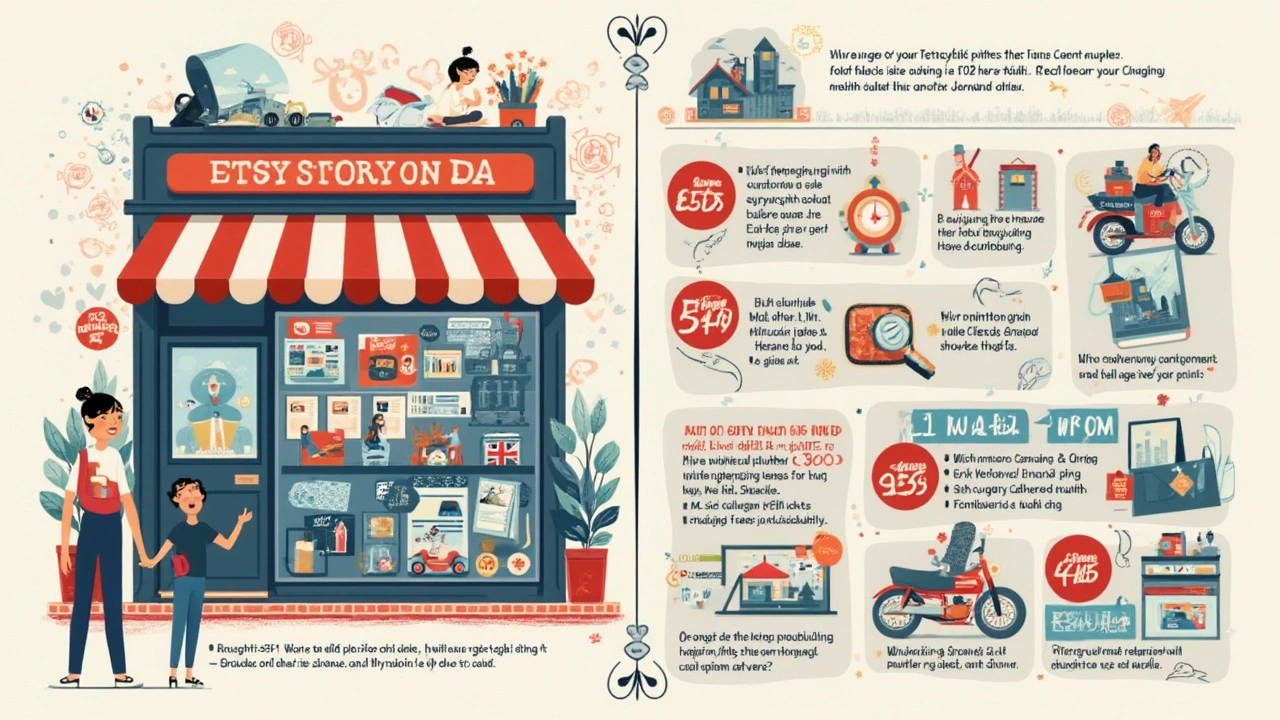Diving into the world of online art sales feels a bit like deciding to get a puppy: the dream's gorgeous, but the reality can get messy. My daughter Maris recently sold her first digital print on Etsy—it pinged her phone late at night, and let me tell you, the smile lasted till breakfast. But is the thrill of that notification really worth all the work behind an Etsy art print shop?
The State of Selling Art Prints on Etsy in 2025
Right now, Etsy is crowded. In June 2025, the platform sits at over 8.8 million active sellers, with "art print" pulling up nearly 6 million results. The demand’s there: sold art prints made up around 13% of Etsy’s top searched items in the last 12 months according to the 2025 Etsy Seller Trends Report. But competition? As wild as Whiskers when he spots a fluttering moth.
Success isn’t just about posting pretty pictures. Algorithms favor steady activity, quick shipping, and gleaming five-star reviews. You are playing both artist and marketer, part customer service rep, sometimes even amateur photographer (unless you want your product pics looking like Eldon’s attempt at photographing his breakfast cereal—lots of blur, zero appeal).
One cool thing: Etsy users still love art that feels personal. In 2025, "custom quote prints" and "pet portraits" are two categories seeing 45% faster growth than generic prints. So, if you specialize or tap into trends (nostalgic retro, minimalist line art), your odds get a boost.
The average successful Etsy art print store earns anywhere from $500 to $2,000 per month, but that hides a wide gap—from side-hustlers making coffee money to full-timers quitting day jobs. Etsy takes a 20-cent listing fee and a 6.5% transaction fee, plus payment processing (around 3% + 25¢ per sale in the U.S.), not counting the cost for shipping materials, printing, and packaging. Suddenly, the profit margins feel tighter than Maris’s favorite skinny jeans.
Take a look at this quick breakdown (yes, it’s specific for 2025):
| Item | Fee/Cost (USD) |
|---|---|
| Listing Fee (per item) | $0.20 |
| Transaction Fee (per sale) | 6.5% |
| Payment Processing | 3% + $0.25 |
| Average Shipping Materials (domestic) | $1.50 |
| Print Production Cost (8x10”) | $2.75 |
When selling a $20 print, expect between $3-$5 in fees, not counting Etsy Ads if you run them. So do the math for your own shop—then see if it feels worth your energy.
What Sells: Finding Your Niche and Standing Out
Scrolling through Etsy can almost feel like panning for gold—there’s beauty, oddity, and a lot of noise. In 2025, niches win. Not just anything pretty, but art that speaks to tight audiences: musical lyric prints, moody botanicals, pop culture cats (that last one got at least five orders last month in Maris’s shop—hat tip to Whiskers as muse). Personalized items drive more repeat business; a paper published in the Journal of Digital Commerce last year showed personalized art prints get 37% more clicks and conversions versus non-custom ones.
Customers expect not just a product, but an experience. They want lush imagery in listings, tips on framing, little stories behind the art. Consider behind-the-scenes videos or time-lapse snippets of your process—people like seeing the magic before they buy the rabbit. Social media is huge. Many top sellers attribute 60% of their traffic to Instagram, TikTok, and Pinterest. If you’re not sharing, you’re missing out.
Also, know your style but stay flexible. Trends move fast: Y2K aesthetics, brighter palettes, and maximalist gallery walls are all popular in 2025, but underground micro-trends—like “kindergarten doodle abstracts”—sometimes explode out of nowhere. Join Etsy forums or subreddits to spot what’s bubbling up. When something fits your style and you can stand more than two hours making it, try a test run. Adjust fast if it flops.
- Research top-selling stores: see what works in photos, descriptions, pricing
- Use the Etsy search bar: type words halfway and see the auto-complete trends
- Fill out all 13 tags: mix broad ones ("wall art") with specifics ("retro cat print")
- Offer different sizes: people love choices, especially for gallery wall projects
- Update listings frequently: the system loves activity and "freshness"

The Work Behind the Curtain: More Than Just Art
Okay, so maybe you’ve got killer artwork. But here’s what you’re really signing up for: logistics. Creating is maybe 30% of the job (and that’s on a good day, with no spilled orange juice across the table). Prepping digital files for prints requires sharp attention—Etsy buyers expect crisp lines and true colors. A single fuzzy print or crooked trim and reviews will haunt you like a cat at snack time.
Packing and shipping can suck the joy out of things if you’re unprepared. Those who thrive usually batch print runs and prep “shipping stations”—a little corner with envelopes, cardboard, and thank-you notes. Weird tip that works: adding a handwritten note ups your chances of a positive review by about 22%, based on feedback trends analyzed by eRank in 2025. Automated print-on-demand options like Printful or Gooten have made it easier to scale, but takes a bite out of earnings and means less control over quality (and yes, Whiskers knocked one of my sample prints into the litter box last spring, so if you print at home, store things high).
Customer service is what can make or break you. Etsy buyers are chatty—they’ll message about shipping times, custom requests, or even just to say they love your work. Speed and kindness pay off. The Etsy Star Seller badge, introduced in 2022, still matters; fast response time and 5-star reviews will boost your ranking. You’ll juggle marketing, inventory, taxes, and sometimes a dash of therapy—because creative burnout is real. Remember to invest time in yourself, or you’ll burn out faster than a scented candle in a power outage.
- Dedicate a spot in your home for order prep
- Set up auto-responses for common questions
- Stick to schedules: printing once a week, shipping every two days
- Track expenses meticulously: use apps like QuickBooks or Wave
- Filter and organize buyer messages for smoother workflow
Marketing Tricks That Actually Work
So you made your art. You put it on Etsy. That’s great—but if you build it, they won’t necessarily come. Most new shops spend weeks (even months) stuck on the second page of search. Here’s where you get creative outside the canvas.
Photos are make-or-break. Bright, natural light, plain backgrounds, and close-ups that show texture—those little touches can boost views. In 2025, buyers are more likely to click on listings with at least five images and one video. Offer context: hang your print on a wall, nestle it among real books or plants, not just a sad white background. Think how you’d show it off to a friend stopping for coffee.
SEO isn’t just a buzzword. Use keywords buyers might actually search—check the "sell art prints on Etsy" auto-suggestions when you type in the search bar. Don’t ignore social media. Even with all my kids’ eye-rolling, Instagram carousels and TikTok time-lapses keep traffic rolling in. Pinterest is slept on—try posting pins that link directly to listings, since it’s still the platform bringing in the most converting traffic for art in 2025 (Pinterest’s own data puts this at 37% of all clicks to art print shops).
Consider collaborations. Partner up with home decor influencers, or bundle your prints with small creators’ goods in mutual giveaways. Sometimes one shoutout feels better than a week of paid Etsy ads. And don’t skip email lists—even if you start with just a few names, drop bi-monthly notes with sneak peeks or discounts. A tiny group of superfans buys more (and shares your shop when you least expect it).
- Optimize every listing for mobile shopping (70% of Etsy buyers shop from phones)
- Rotate banners and featured listings to keep your shoplet looking ‘fresh’
- Track which pins, posts, or ads bring in actual buyers (Google Analytics helps)
- Ask happy customers for photo reviews—social proof lands more sales
- Run periodic flash sales to clear slower-moving designs

Should You Sell Art Prints on Etsy—or Try Something Else?
All this boils down to your own goals—and what you want your art hustle to look like. If you want a quick buck, Etsy probably isn't the dream shortcut. It shines for artists looking for real feedback, gradual growth, and the pride that comes from running your own (tiny, sometimes messy) shop. If you hate customer service or shudder at shipping, print-on-demand or other platforms—like Redbubble, Society6, or Saatchi Art—might suit you better, though competition and fees play out differently.
Many artists blend platforms: start with Etsy, build an audience, and then gently guide superfans to your own site, newsletter, or in-person shows. Etsy’s great for getting discovered if you play the long game—think months, not miracle days. Just know: it’s work. Whiskers may nap all afternoon, but successful Etsy shops rarely get lazy breaks. If you can ride out the slow months, keep tweaking, and actually enjoy connecting with buyers, the payoff can stretch beyond money—like seeing your print hang in someone else’s home halfway across the world. That’s the stuff you remember, even after the stats fade and the five-star reviews start feeling normal.
For anyone weighing up the leap, my advice is start small but smart: upload what you love, learn as you go. Talk to other artists, use every tool Etsy gives you (they’re sneaky with new features and pop-ups—read those update emails), and don’t measure yourself against shops with a decade-long head start. Sometimes a single sale makes all the work feel worth it—just ask Maris, whose first happy review is still stuck to our fridge with a cat magnet. That’s the kind of ‘worth it’ you can’t put in a spreadsheet.





